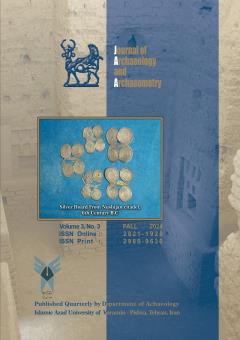Study and Analysis of the Inscriptions Arrays of Imam Mosque in Tehran
Subject Areas : Archaeology
Sohailaا Abipour
1
![]() ,
Nader Karimian Sardashti
2
*
,
Nader Karimian Sardashti
2
*
![]() ,
Sina Foroozesh
3
,
Sina Foroozesh
3
![]()
1 - Department of Archaeology, Science and Research Branch, Islamic Azad University, Tehran, Iran
2 - Department of Archaeology of Iranian Center for Archaeological Research (ICAR), Tehran, Iran
3 - Department of Archaeology, Science and Research Branch, Islamic Azad University, Tehran, Iran
Keywords: Imam Mosque, inscription, Fath Ali Shah, Qajar period, Tehran.,
Abstract :
Calligraphy in Islamic art is regarded as sacred due to its connection with the divine word. The Quran itself references the sanctity of the pen, the value of writing, and swears by them. Inscriptions are the only visual elements that directly carry meaning and hold significant importance in the architectural structures of the Islamic period in Iran from both visual and content perspectives. The aim of this paper is to achieve favorable results in response to the following questions: What were the goals and exp Study and Analysis of the Inscriptions Arrays of Imam Mosque in Tehran.ectations of the designers and writers in composing and designing the inscriptions? What elements and components shaped the themes of the mosque's inscriptions? The results of field and library studies indicate that the artists' goal in writing and designing the inscriptions was to create a building worthy of the Muslim community that would attract the attention of every viewer and provide spiritual tranquility. Additionally, the expectation of the designers and writers in composing these inscriptions was to immortalize their memory in the field of art and architecture. Based on the study and analysis of the inscriptions, it appears that most of the inscriptions in Imam (Shah) Mosque are derived from the Quran and contain poems praising FathAliShah, the names of Qajar kings, the names of artists, poets, and verses that indicate the date of the building's construction
- Balaghi, Hojjat (1971), History of Tehran (Central and Surrounding Areas), Qom: Ministry of Education.
- Behpour, Bavand (2005), “Inscription Writing in the Qajar Period,” *Fine Arts*, 22: 84-99.
- Pope, Arthur (2009), *Architecture of Iran*, translated by Gholamhossein Sadri Afshar, Tehran: Samira.
- Polak, Jacob Edward (1989), Polak's Travelogue (Iran and Iranians), translated by Kikaus Jahandari Khwarazmi, Tehran.
- Collective Authors (1998), Ganjnameh: Culture of Islamic Architectural Works in Iran, Volume Three (Religious Buildings in Tehran), Tehran: Center for Documentation and Research of the Faculty of Architecture and Urban Planning.
- Khodadadi Naeini, Saeed (2011), “Shahnameh of Fath Ali Khan Saba: A Masterpiece of Qajar Art (Copy 5998 of Malek Library),” Mirror of Heritage, 9 (1): 47-70.
- Zahabi, Abolfazl (1985), “Calligraphy in the Islamic World,” Art Quarterly, 8: 44-77.
- Sadat Razavi, Zamzam; Gozehgar, Mohammad Baghestani; and Salim, Mohammad Nabi (2019), “Mosque Construction in Tehran during the Qajar Era,” Scientific-Research Journal of Historical Studies, 14 (56): 67-88.
- Saki, Nancy (2022), “The Role and Influence of Quranic Verses in Mosque Architecture (Focusing on the Quranic Inscriptions of the Jameh Mosque of Isfahan),” Studies in Islamic Art, 19 (48): 468-484.
- Saleh Shirazi, Mirza (1985), Collection of Travelogues, edited by Gholamhossein Mirza Saleh, Tehran: History of Iran.
- Solhjoo, Jamileh (2017), Examination and Introduction of Notable Architectural Works in Bukan County during the Qajar Era. Master's thesis in Islamic Archaeology, supervised by Ahmad Salehi Kakhki, Faculty of Conservation and Restoration, University of Art Isfahan.
- Abdolmaleki, Reza Qanbari (2016), “Examination of Poets' Reactions to the Phenomenon of the Iran-Russia War,” Persian Literature, 6 (1): 173-192.
- Fadaei, Mojgan (2016), Form and Meaning in the Inscriptions of Qajar Mosque Tile Work, Master's thesis in Islamic Art, supervised by Alireza Razeqi, Faculty of Conservation and Restoration, University of Art.
- Fraser, James Baillie (1985), Fraser's Travelogue, translated by Manoochehr Amiri, Tehran: Tosse.
- Flanden, Eugene (1947), Eugene Flanden's Travelogue to Iran, translated by Hossein Noor Sadeghi, Tehran: Eshraghi.
- Ghaem-Maghami, Jahangir (1948), “Figures of the Qajar Era: Biography of Malek-ol-Ketab Farahani,” Yadegar, 8: 23-36.
- Karimian, Hossein (1976), Tehran in the Past and Present, Tehran: National University of Iran.
- Moshkooti, Nasrollah (1970), List of Historical Buildings and Archaeological Sites in Iran, Tehran: National Organization for the Protection of Historical Sites.
- Mostafavi, Mohammad Taqi (1982), Historical Works of Tehran (Holy Places), Tehran: National Heritage Association.
- Mo'tamedi, Mohsen (2002), Historical Geography of Tehran, Tehran: Tehran University.
- Maki Nejad, Mehdi (2009), “The Evolution of Thuluth Inscriptions in Iranian Architecture (Safavid and Qajar),” Analytical-Research Quarterly of Negareh, 13: 29-39.
- Nourbakhsh, Masoud (2002), Tehran as Narrated by History (Tehran from Ancient Times to the Naseri Era), Tehran: Elm.

